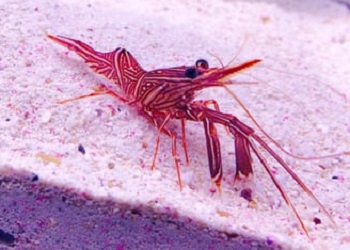Description
The Camel Shrimp is a hardy saltwater shrimp. Camel shrimp are easily identified by their characteristic "hump" for which they are aptly named. They are sometimes confused with the similarly colored peppermint shrimp. Camel Shrimp are also commonly known as Camelback Shrimp, Hinge Beak Shrimp, Dancing Shrimp, Candy Shrimp, and Humpback Shrimp. Covered with red and white stripes that run across the entire body. The Camel Shrimp, Rhynchocinetes uritai has a movable rostrum or beak that is generally facing upwards. They have ornate markings and large reflective eyes. The size of their eyes is an indicator of their natural ability to move around well in low-light conditions, Male camelback shrimp have larger chelipeds or claws, compared to the female. The claw isn't formed until the shrimp reaches maturity.
Like most shrimp species, Camel Shrimp are nocturnal shrimp that usually hides during daylight hours, coming out at night to feed. When the light is dim or turned off, you might be able to bring this shrimp out of hiding. It is not unusual to see them picking materials and debris from rocks and other hard surfaces in the aquarium. Camel shrimp are best suited to tanks with an abundance of live rock. It prefers to be with other shrimp of its kind in rock crevasses, under overhangs, or in the coral rubble. It usually tolerates all other shrimp.
Shrimp need to undergo molting as they grow. Molting is a process in which Rhynchocinetes uritai shed their current and tight exoskeleton to replace it with a new and larger one. Camelback shrimp molt at night. The shrimp lies on its back to shed its old exoskeleton. The new exoskeleton is then secreted by its body, which forms and hardens completely in a few hours. The shrimp probably feels vulnerable without its outer shell, so it usually hides in rock crevices or rock caves during the molting process to allow the new exoskeleton to form and completely harden. If you have a reef aquarium camel shrimp may pick at mushroom corals, and soft leather corals. It generally leaves bubble corals and anemones.
Diet and Feeding
Camel Shrimp will accept a varied diet of fresh and frozen foods, suitable for carnivores, vitamin-enriched flakes, fine sinking pellets, freeze-dried krill, frozen or freeze-dried plankton, brine shrimp, mysis shrimp, finely chopped prawn, mussels, clams, or cockle meat, or nauplii (crustacean larvae) are all great foods for this shrimp. Feed at least once per day.
Level of Care Easy
Reef Compatibility With Caution
|



